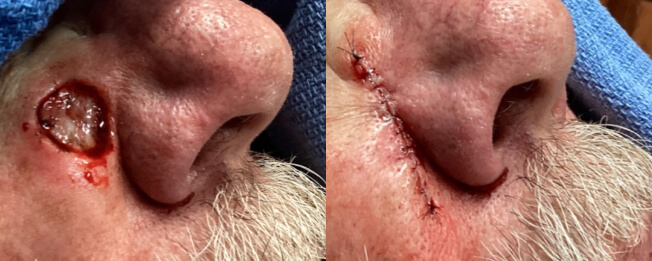Dermatologic Surgery
Dermatologic surgery is a specialized field of medicine that focuses on diagnosing and treating skin conditions using surgical techniques. Dermatologic surgeon Ilya Lim, M.D., FAAD has undergone specialized training to perform a wide range of surgical procedures on the skin, including the removal of skin cancers, moles, and other growths, as well as the treatment of scars and other cosmetic concerns.
Dermatologic surgery may involve a variety of techniques, such as excision (cutting out tissue), electrosurgery (using an electric current to remove tissue), laser surgery (using a laser to remove tissue), and cryosurgery (using liquid nitrogen to freeze and remove tissue). The goal of dermatologic surgery is to provide patients with the best possible outcomes while minimizing scarring and other potential complications.

What is dermatologic surgery?
Dermatologic surgery refers to any cutting of the skin to remove or treat skin concerns, including skin cancer and various growths. The team at the Institute of Dermatology & Oculoplastic Surgery performs these surgeries carefully to preserve as much healthy skin as possible while getting rid of the cause of your concern.
A biopsy, which is a diagnostic skin surgery, may be used to remove a portion of a particular mole or growth on the skin ahead of time. The team tests the sample in a laboratory for signs of cancer or to figure out what the growth is. Depending on their findings, they may recommend dermatologic
surgery to remove the remainder of the lesion.
What can dermatologic surgery treat?
Dermatologic surgery is an essential treatment for many skin conditions and growths, both common and uncommon. The team at the Institute of Dermatology & Oculoplastic Surgery may use dermatologic surgery to remove:
Squamous cell carcinoma
Squamous cell carcinoma is a type of skin cancer affecting the uppermost cells in the epidermis. It usually develops in areas that have seen a lot of sunlight, like your scalp or arms.
Basal cell carcinoma
Basal cell carcinoma is a type of skin cancer similar to squamous cell carcinoma. The basal cells are still in the epidermis, but in the lower portion. This type also commonly comes from sun damage.
Melanoma
Melanoma is a more dangerous type of skin cancer because it’s more likely to spread. It originates in melanocytes, a type of cell that produces your skin’s pigment.
Cysts
Cysts are sacs in the skin full of liquid or a mushy substance. While most are harmless, they can involve inflammation, tenderness, and even pain. Your dermatologist removes the entire cyst, including its sac, to prevent it from returning.
Lipomas
A lipoma is a fatty lump growing between skin and muscle. Like cysts, they’re usually harmless. However, depending on the location, they can place pressure on nerves to cause discomfort or pain.

Our Mission Is To Help You
Live Your Best Life Every Single Day.
How should I prepare for dermatologic surgery?
You may feel nervous about possible discomfort or future scarring before dermatologic surgery. However, the team at the Institute of Dermatology & Oculoplastic Surgery is happy to answer your questions and settle any concerns. They discuss numbing options and recovery ahead of time, so you know what to expect.
Before your surgery, the team also lets you know which technique they’ll use. While many dermatologic surgeries are performed via excision with a scalpel, other options include Mohs surgery for certain skin cancers, as well as cryosurgery or electrosurgery. Depending on the size of the lesion you’re removing, you might also need a skin graft.
To learn more about dermatologic surgery and what to expect from the process, call the Institute of Dermatology & Oculoplastic Surgery or book an appointment online today.
